Fable: The Journey Review
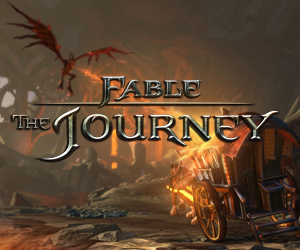 Game: Fable: The Journey
Game: Fable: The Journey
Developer: Lionhead Studios
Publisher: Microsoft Game Studios
Available on: Xbox 360 with Kinect Only
Like it or love it, the Fable series from Lionhead Studios hasn’t been breaking any radical new ground from instalment to instalment. The lofty ambitions of former director Peter Molyneux were never quite reached, and even though each game has tried to introduce new elements, all three Fable games feel very similar to one another. It is with the Xbox 360’s motion sensor Kinect however – after Peter Molyneux’s much talked about Kate & Milo pet project was canned – that the series finally takes strides out in a new direction, and although the setting may be familiar to us, the gameplay is entirely different.
STORY: This is the first Fable title that won’t see players taking on the role of the latest member of the Hero bloodline. The line of Hero ancestors has failed, and the last set of heroes went about putting a fail safe in place, whereby a normal person who was deemed worthy, who showed the kindness and fortitude to bear the burden, could become the next hero of Albion. Enter Gabriel, part of a nomadic tribe who traverse the lands in their horse drawn carts. His best friend is his horse Seren, and the two of them are quite content.
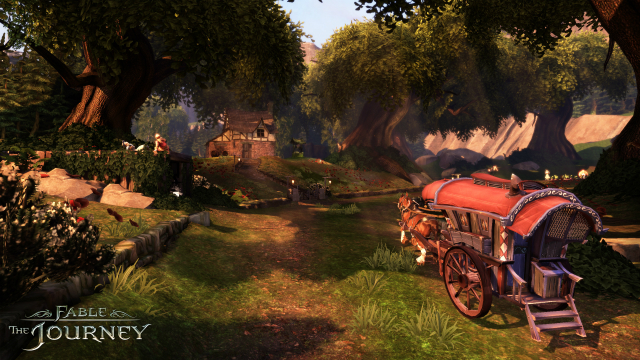
Gabriel is by no means a brave man, and doesn’t seem like your typical hero, but through a series of chance events he finds himself separated from his group and he finds a mysterious blind lady on the side of the road. This is, of course, Theresa, the guide from previous Fable games, who is in fact a Seer, and Gabriel has just unwittingly saved her from a terrible enemy; the shadow-like Devourer that was also the final nemesis in Fable III. You will have to travel across Albion and find the Temples of Will in order to find new spells and learn new skills – all of which you will use to overcome the enemy.
As you would expect from a Fable game, the story has both dramatic and comedic elements working to push the plot forwards, but it is far less complex than in the past. The hero and the other new characters who are introduced are interesting and the bond between man and horse is nicely handled. Another interesting point is the way that the long-standing Theresa character is developed, and we learn more of her backstory that has been largely overlooked in previous entries. The only negative is that the writing doesn’t seem to have quite the same bite and sardonic British humour that is a staple of the series, the game seems to be targeted more at a younger audience and, as such, the conversations are never too demanding, and sometimes the cutscenes seem too short or shallow. This does result in some rather flat sequences, where the player maybe doesn’t feel the energy and excitement that the sequence demands.
GRAPHICS: You have to say that The Journey is certainly the best-looking Fable game that has ever been put together. Made using the Unreal Engine, the title features far more detail and nicer ambient effects than Fable III, with smooth animations that also perform admirably at high speeds. It is just somewhat of a shame that, with the game being on rails, the player never gets the chance to simply explore and admire the landscape; everything whizzes by far too quickly.
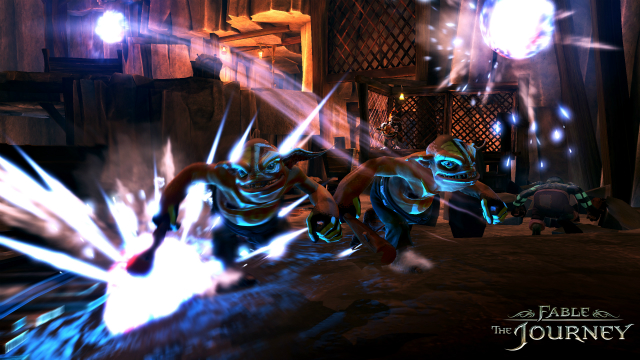
SOUND: The sound design is probably the strongest point of the title, and the music in particular is at the same high standards that the series is known for. Whether it be an action-packed fight, as chase scene or a moment for reflection, the music sets the mood admirably, bringing Albion to life even when the story may not be grabbing you. The rest of the sound is equally impressive, with background birdsong or spooky echoes heightening the experience. Not to mention the voice acting, which features a large cast of British actors.
GAMEPLAY: Unfortunately, where the game really starts to fall down is the gameplay, and that is obviously the most important aspect of any game. Gone is the free-roaming, exploratory RPG that we have come to expect from Fable and instead The Journey plays a lot more like House of the Dead; albeit with magic and horses. That is the first real thing that players will notice, you have no control over the movement in the game, aside from in the rest-stop areas that crop up from time to time, all of the fighting, chases and boss battles are entirely on-rails. Of course, this does allow the designers to keep a tight rein in on the direction of the game – just like a film camera – but it severely cuts down on the player interaction and feel of immersion in the title. You are simply sitting by and reacting as the world moves around you, making the game a very passive experience.
The two main things you will find yourself doing in the game are casting spells and driving your horse-drawn wagon. Let us start with your horse Saren, and her associated tasks. These are all quite logical, with the character taking hold of the reins to perform all of the controls. Whipping the reins speeds the horse up, between two speed levels and a limited boost period, and pulling back on them will act as a brake. These are picked up with very good accuracy by the Kinect sensor, and The Journey is ambitious in the fact that it is the first Kinect game that actively asks you to sit whilst playing. This is easier on the body, as such a long game would clearly get tiring if the player were to stand, and impressively it doesn’t seem to effect the detection sensitivity.
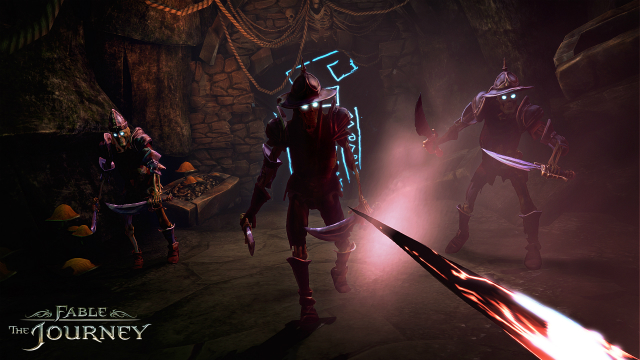
You steer the carriage by pulling and pushing your hands forwards and backwards alternately, as if turning a large invisible wheel, which also works well, and bigger turns are performed by bigger movements, making it a good system. The bulk of your driving will either involve you simply moving from one location to the next, collecting experience orbs that are scattered in the road and which build up to allow you to buy magic, health and horse upgrades, or chase scenes. The collecting ones are quite sedate, and can become a little boring as some stretches are rather long and repetitive, despite the odd horde of Hobbes being thrown in the mix. The chases, where the dark shadow of the Devourer tries to catch up with you and engulf you, are, in contrast, fast and frantic, but often the obstacles that appear in the road for you to dodge as you run away appear too quickly for you to turn out of the way; making them frustrating in a whole different way.
Rest stops can be found along the way where the player can heal Saren’s wounds by the placing of your hands on her body with your magic gauntlets, which is a nice touch, but perhaps occurs too often. Less frequently, you will set up camp, where you can gain experience through such tasks as brushing Saren or giving her apples as she rests. These rest-stops are also one of the main spots that you will find chests scattered, which hold collectable items. These rest stops would be a welcome change of pace, but for the fact that most of the interactions here seem fairly pointless, and it will make little difference whether you bothered to perform them or just to leave and continue your adventure as soon as possible.
The spell casting is another kettle of fish entirely. When you first learn magic, you will go through a Kinect calibration sequence, which can be repeated at any time if you feel your magic aiming is a little off. The problem is, the calibration always seems to work fine, but when you get into the heat of the battle, you can’t seem to hit a cow’s backside with a barn door. The main issue is that when you throw magic spells with either hand (in a perfectly understandable motion), you aim at the screen where you wish to throw it. However, because the designers included no kind of cross-hairs, it is difficult to judge where your aim is in relation to the on-screen action. You inevitabley end up aiming far too low or far too high, and if there was an accuracy counter in the game it would certainly always be very low. A simple crosshair or aiming point added to the HUD would have helped no end, and would have allowed the player to judge their shots, rather than aiming blindly and yelling at the screen every five seconds. It does become very frustrating hitting your targets at distance, whereas close-range is less of an issue.
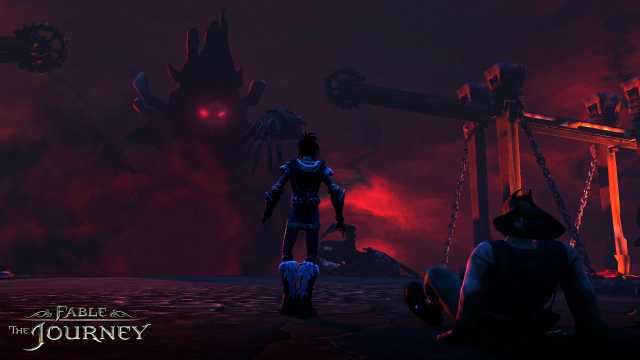
You will learn a variety of spells, and these can be activated by actions or you can even switch between them with voice commands, and I would say that the voice recognition in the title is spot-on. Voice commands were probably more successful than motion ones in my experience, which is a sad statement on the spell-casting motion controls. You do get the hang of it somewhat after a while, and once you learn to combine your different attacking spells, and the defensive ones together, you really can pull off some very satisfying combos, after which you may start to feel a little like a powerful wizard, but just around every corner you will have another four of five terrible misses, which will knock your enthusiasm all the way back down.
LONGEVITY: The campaign is actually quite lengthy, not only for a Kinect title, and is likely to keep you busy for quite some time. Obviously the on-rails style of the game does lead to the overall experience being a pretty linear one, with no deviation from the path which the developers have set you on, so there are few distractions or side-bars to keep you busy, but the main bulk of the story will take a good amount of time to get through. Add to that the fact that all of the action sequences, or memorable battles can be re-played in Arcade mode, where players can try to achieve certain scores in order to attain Bronze, Silver or Gold medals, and there is a little re-playability in the title; providing you enjoyed the ten Arcade mode sections enough in the main game to want to go through them again one by one. There are also collectables to find, but you will likely find most of these in one play-through, as they are all clearly signposted and are mainly found in the obvious chests scattered around Albion.
VERDICT: The Journey is a great risk, that sadly doesn’t pay off entirely. There are a lot of impressive features to the title such as the voice commands, the sitting Kinect detection and the sublime sound design, but the things that make up the bulk of the title, the driving and the spell-casting, suffer from poor implementation or frustrating and boring gameplay. Whereas the old Fable games encouraged exploration and experimentation, where you could shape the game to your own preferences and literally change your character according to your actions, The Journey is almost entirely linear, which is sure to disappoint long-time Fable fans. We know that Kinect can be very accurate and pick up a variety of movements from other successful titles using the sensor, the game has been undermined by some poor control choices. The simple addition of a crosshair of sorts may have intruded on-screen and gone against the designers wishes, but it would have no doubt made the game much more fun to play. It is an ambitious attempt at making a more traditional game for Kinect, and it certainly can be a lot of fun, and is an impressive feat; when it works.





